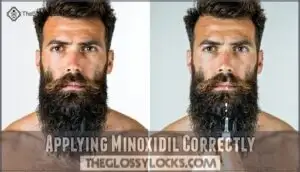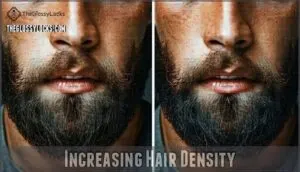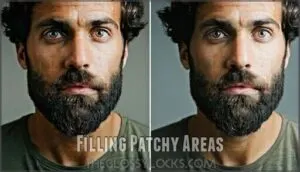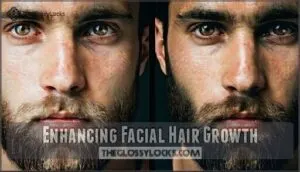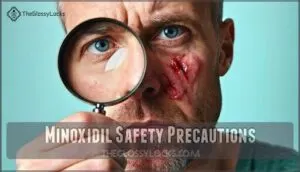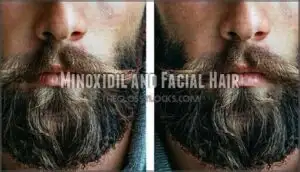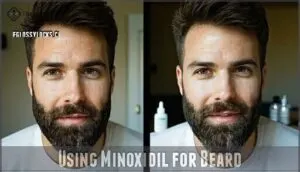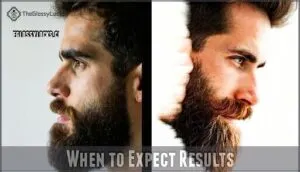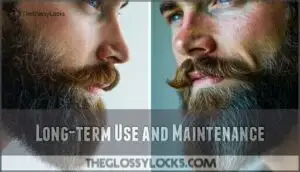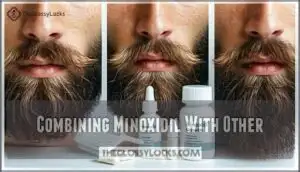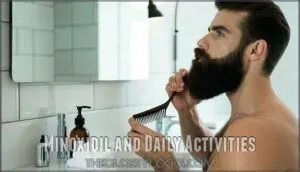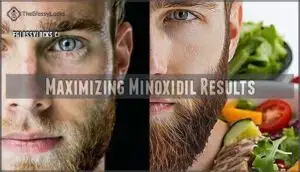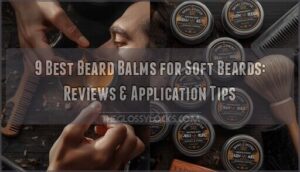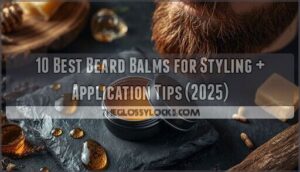This site is supported by our readers. We may earn a commission, at no cost to you, if you purchase through links.
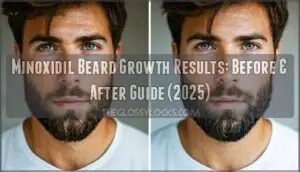
The science is straightforward: minoxidil extends your hair’s growth phase and converts those wispy vellus hairs into thick, terminal beard hairs.
Clinical studies show 80% of men using 5% minoxidil twice daily develop noticeable improvements, with peak results around the 12-month mark.
Don’t expect overnight transformation—you’ll likely experience initial shedding before the real growth kicks in.
Your genetics, age, and application consistency all play pivotal roles in determining your final outcome and timeline success.
Table Of Contents
- Key Takeaways
- Minoxidil Beard Growth
- Applying Minoxidil Correctly
- Minoxidil Effects on Beard
- Minoxidil Safety Precautions
- Minoxidil and Facial Hair
- Using Minoxidil for Beard
- Minoxidil Treatment Timeline
- Combining Minoxidil With Other
- Minoxidil and Daily Activities
- Maximizing Minoxidil Results
- Frequently Asked Questions (FAQs)
- Does minoxidil help grow a beard?
- Are minoxidil beard results permanent?
- How long does minoxidil take to work for beard growth?
- What are the side effects of minoxidil beard growth?
- What is the difference between minoxidil 5% and 2% for beard growth?
- How long does minoxidil take to grow a beard?
- Does minoxidil effective for beard growth?
- Can 5% minoxidil grow a beard?
- Can minoxidil cause permanent facial hair changes?
- What happens when you stop using minoxidil?
- Conclusion
Key Takeaways
- You’ll see initial minoxidil beard results after 3-6 months of consistent twice-daily application, with peak growth occurring around 12 months and 80% of men experiencing noticeable improvements.
- You need to apply 1ml of 5% minoxidil to clean, dry skin twice daily, waiting 4 hours before washing your face to ensure proper absorption and maximize effectiveness.
- You’ll experience an initial shedding phase in weeks 2-4 before real growth begins, as minoxidil converts fine vellus hairs into thicker terminal hairs through increased blood flow to follicles.
- You must maintain consistent long-term use for 1.5-2.5 years to preserve results, as stopping minoxidil will gradually reverse your beard growth gains over several months.
Minoxidil Beard Growth
You’re probably wondering if minoxidil can actually help you grow a fuller, thicker beard, and the answer is more promising than you might expect.
Originally developed as a blood pressure medication, minoxidil works by increasing blood flow to your hair follicles, which can stimulate facial hair growth and help fill in those frustrating patchy areas that make your beard look uneven.
How Minoxidil Works
Minoxidil transforms your patchy beard through precise biochemical action.
Unlock your beard’s hidden potential with the proven power of enhanced blood flow and follicle activation.
This powerful vasodilator works by opening potassium channels in blood vessels, triggering vasodilation that increases blood circulation to hair follicles.
Here’s how minoxidil kickstarts your beard transformation:
- Sulfate conversion activates the compound within your skin
- Anagen prolongation extends your hair growth cycle substantially
- Enhanced blood supply nourishes dormant follicles back to life
Benefits for Beard Growth
Understanding how this treatment works sets the stage for recognizing its specific advantages.
Your minoxidil beard journey offers three key benefits that transform patchy facial hair into fuller coverage.
| Benefit | How It Helps |
|---|---|
| Density Improvement | Increases hair follicle count and thickness for fuller beard gains |
| Patchy Coverage | Fills sparse areas where natural growth struggles to develop |
| Anagen Prolongation | Extends growth phase, allowing longer, stronger minoxidil results through improved blood flow and sustained hair regrowth cycles |
Clinical Evidence and Studies
Research backing minoxidil beard effectiveness remains limited but promising.
A 2016 placebo-controlled study showed 3% concentration produced measurable facial hair increases after 16 weeks.
Recent 2024 twin studies using 5% minoxidil demonstrated clear results.
Dermatologist-reviewed hair growth studies indicate efficacy varies by individual, with transgender studies showing positive outcomes when combined with hormone therapy for enhanced hair growth effectiveness.
Applying Minoxidil Correctly
Proper application technique can make the difference between patchy results and the fuller beard you’re working toward.
You’ll need to apply 1ml of minoxidil twice daily to clean, dry skin, allowing four hours between application and washing your face to guarantee maximum absorption.
Daily Application Process
Every morning and evening, you’ll need to establish a consistent minoxidil routine that becomes second nature.
Start with skin preparation by washing your face, then apply 1ml of product to your damp face application areas.
Massage gently until product absorption occurs, maintaining application timing twelve hours apart.
Post-application care requires waiting four hours before washing, ensuring application consistency and application frequency success.
Common Application Mistakes
Most guys sabotage their minoxidil application without realizing it.
Inconsistent application ruins progress, while over-application risks increase side effects without boosting results.
Skipping patch tests on unclean skin prevents proper absorption.
You’re wasting product by applying to wet faces instead of damp skin.
Master application technique and consistency—your beard depends on it.
Many users encounter common application problems.
Tips for Effective Use
Perfect application timing makes all the difference in your minoxidil routine. Apply to clean, dry skin twice daily, spacing doses twelve hours apart for ideal product absorption.
Master proper massage techniques by gently working the solution into your skin for two minutes. Consider additional product options for enhanced results.
Maintain skin hydration with a light moisturizer after the four-hour absorption window to minimize minoxidil side effects and maximize beard growth effectiveness.
Minoxidil Effects on Beard
You’ll notice minoxidil’s effects on your beard happen gradually, starting with increased blood flow to dormant follicles that encourages new hair growth in previously patchy areas.
The treatment works by extending your hair’s growth phase and converting fine vellus hairs into thicker, darker terminal hairs, giving you the fuller beard coverage you’re seeking.
Increasing Hair Density
Minoxidil’s primary strength lies in boosting overall beard density through enhanced follicle stimulation and improved blood circulation.
You’ll notice increased hair diameter as the treatment extends anagen duration, allowing follicles more time to develop. Better nutrient delivery means each hair grows thicker and stronger.
Studies show minoxidil foam substantially improves facial hair density, with measurable increases in beard growth after consistent use. Many users seek products for minoxidil beard density.
Filling Patchy Areas
Your patchy beard doesn’t have to stay that way.
Minoxidil excels at filling those stubborn bare spots where facial hair density falls short.
The vasodilator targets sparse area growth by increasing blood flow to dormant follicles in hairline gaps.
Complete coverage becomes achievable as minoxidil stimulates new growth in previously barren patches, delivering the density improvement you’ve been seeking, with increasing blood flow to support this growth.
Enhancing Facial Hair Growth
Beyond addressing sparse spots, minoxidil foam works to enhance your overall facial hair density by converting vellus hairs into stronger terminal strands.
Your beard genetics, ethnicity factors, and DHT sensitivity all influence minoxidil effectiveness, though age can slow results.
Here’s how enhanced growth unfolds:
- Thicker individual hair strands create fuller appearance
- Faster growth cycles reduce waiting time between trims
- Improved coverage across jawline and cheek areas
- Better hair quality with increased pigmentation
This process leads to a more robust and healthier-looking beard, as the combination of thicker individual hair strands and faster growth cycles contributes to an overall improvement in beard appearance.
Minoxidil Safety Precautions
Before you start applying minoxidil to your face, you’ll need to understand the potential side effects and safety measures that come with this powerful treatment.
While most men experience only mild skin irritation like redness or dryness, knowing how to recognize and prevent more serious reactions can save you from uncomfortable surprises down the road, and help you manage any potential reactions.
Common Side Effects
While minoxidil can transform patchy beards, you’ll likely experience some bumps along the road.
Skin irritation, redness, and dryness are your most common companions during treatment.
Initial shedding might alarm you in weeks 2-4, but this signals healthy follicle cycling.
Watch for allergic reactions like burning or excessive flaking, which require immediate attention and possible discontinuation.
Rare but Serious Side Effects
While most users experience only mild irritation, minoxidil can trigger serious systemic side effects that demand immediate medical attention.
These rare complications include:
- Cardiovascular issues – chest pain, irregular heartbeat, or worsened heart conditions
- Allergic reactions – severe skin responses requiring dermatologist consultation
- Systemic effects – swollen extremities, dizziness, or changes in blood pressure
- Hormonal changes – reduced sexual desire in some users
Precautions for Sensitive Skin
Testing your skin’s reaction before diving in can save you from unwanted surprises.
Sensitive skin requires extra caution with minoxidil—start with patch testing on a small area first.
Skip toners and avoid aggressive exfoliation, as these increase skin sensitivity and allergic reactions.
Choose gentle moisturizing options to combat dryness.
If irritation develops, discontinue use immediately and seek dermatologist consultation.
Minoxidil and Facial Hair
When you apply minoxidil to your facial area, you’re basically training those fine vellus hairs to transform into the thicker, darker terminal hairs that make up a full beard.
This process works by increasing blood flow to hair follicles and extending the growth phase, though you’ll need patience since converting vellus to terminal hair typically takes several months of consistent use.
Does Minoxidil Grow Vellus Hair
Many men wonder if minoxidil can actually stimulate their existing vellus hairs – those fine, colorless peach fuzz strands covering your face.
The answer is yes, minoxidil success often begins with follicle stimulation of these dormant hair follicles, encouraging vellus transformation into more noticeable growth patterns.
Here’s what happens during this hair maturation process:
- Follicle Stimulation – Minoxidil awakens sleeping vellus hair follicles by increasing blood flow to facial skin
- Vellus Transformation – Fine hairs gradually thicken and darken over the growth timeline
- Hair Maturation – Vellus hairs develop into intermediate hairs before becoming terminal hair
- Beard Growth – Consistent minoxidil application supports this natural progression toward fuller facial hair
Converting Vellus to Terminal Hair
Your body naturally transforms fine vellus hairs into thicker terminal hairs through a process called Vellus Transformation.
Minoxidil Influence accelerates this conversion by stimulating hair follicles and enhancing Growth Factors.
Androgen Receptors in your facial area respond to increased blood flow, helping vellus hairs develop Terminal Characteristics.
This transformation creates the fuller beard growth you’re seeking.
Expectations for Facial Hair Growth
Patience becomes your greatest ally when setting beard growth expectations with minoxidil.
Realistic timelines span 6-12 months for noticeable results, though genetic influence creates significant individual variation among users.
Growth factors differ between men, so don’t expect magazine-perfect results overnight, focus on your personal progress instead, and remember your facial hair journey won’t match someone else’s image expectations.
Your journey is unique, and realistic timelines are essential to understanding the process.
Using Minoxidil for Beard
You’ll want to keep in mind your skin type, health conditions, and realistic expectations before starting minoxidil treatment for beard growth.
While most men can safely use minoxidil, those with sensitive skin, heart conditions, or certain medications should consult their doctor first.
Natural alternatives like castor oil exist for those who prefer gentler options.
Who Should Use Minoxidil
You’re an ideal candidate for minoxidil if you’re over 18 with a patchy beard or low beard density.
Men with genetic predisposition to sparse facial hair often see the best results.
Dermatologists recommend it for those without serious health conditions who maintain realistic expectations.
Your commitment to consistent application matters more than age—minoxidil works when you’re dedicated to the process.
Who Should Avoid Minoxidil
Certain individuals should steer clear of minoxidil due to serious health risks.
If you have heart conditions, blood pressure medication, or drug interactions, consult your healthcare provider first.
Those with dermatological concerns like eczema or chronic skin sensitivities shouldn’t risk the side effects.
Age restrictions apply too—minors need medical approval for dermatological safety.
Alternatives to Minoxidil
Natural oils like rosemary and peppermint offer gentler beard growth alternatives.
Derma rolling stimulates follicles without chemicals, while LLLT therapy uses light to encourage growth.
Beard vitamins and hair growth supplements support healthy development from within.
PRP therapy provides medical-grade results for serious cases.
These hair growth products give you options when minoxidil isn’t suitable, and can be used in conjunction with other treatments for optimal beard growth.
Minoxidil Treatment Timeline
When you start using minoxidil for beard growth, you’ll need to understand the realistic timeline for seeing results, which typically begins around 6-12 weeks but requires consistent use for 6-12 months to achieve meaningful density improvements.
Your beard journey will include an initial shedding phase followed by gradual regrowth, and maintaining your results means committing to long-term daily application since stopping treatment can reverse your progress, emphasizing the importance of consistent use.
When to Expect Results
Timing truly matters when tracking your minoxidil progress.
You’ll notice Initial Growth with fine vellus hairs appearing within 2-3 months of Consistent Use.
The real beard growth transformation happens between 4-6 months as these evolve to terminal hairs.
Document your beard growth timeline with monthly progress photos to track your beard growth stages realistically.
Long-Term Gains require patience through this Realistic Timeline.
Initial Shedding and Regrowth
Don’t panic when you notice increased hair shedding during your first few weeks of minoxidil use. This temporary minoxidil shedding signals your follicles are shifting from resting to active growth phases.
The beard growth timeline includes this necessary step before stronger vellus hair emerges.
Understanding the shedding process helps manage expectations:
- Shedding Duration typically lasts 2-6 weeks as weaker hairs fall out
- Shedding Severity varies but shouldn’t cause noticeable bald patches
- Regrowth Factors include consistent application and individual hair growth stages
Long-term Use and Maintenance
Long-term minoxidil use requires commitment for beard growth preservation.
You’ll need consistent application for 1.5-2.5 years to maintain continued gains.
Some users find success with cycling minoxidil or tapering dosage gradually.
Post-minoxidil care becomes essential as stopping suddenly may reverse progress.
Your future growth depends on maintaining the routine that strengthened those newly developed follicles, ensuring continued gains.
Combining Minoxidil With Other
You can boost your minoxidil results by combining it with proven complementary treatments like derma rolling, natural oils, and targeted supplements.
These methods work together to create better conditions for facial hair growth, with derma rolling improving absorption, oils providing nourishment, and supplements supporting your body’s natural hair production from within.
Derma Rolling for Enhanced Growth
Derma rolling amplifies minoxidil’s beard growth potential by creating microscopic channels that boost serum absorption into hair follicles.
This microneedling technique matters more than you’d think for stubborn patches.
Here’s what makes derma roller sessions game-changing:
- Rolling frequency of once weekly prevents over-stimulation while maximizing results
- Needle size between 0.5-1.0mm penetrates deep enough without causing damage
- Technique matters – gentle, consistent pressure across all beard areas
- Skin sensitivity requires 24-hour breaks between rolling and minoxidil application
Using Natural Oils for Beard Care
Natural oils complement minoxidil’s beard growth effects while providing essential skin health benefits.
Castor oil’s ricinoleic acid stimulates follicles, while peppermint oil increases circulation. Rosemary oil matches minoxidil’s effectiveness in some studies.
Apply these beard oils after your minoxidil treatment dries completely. Oil combinations like jojoba with argan improve beard appearance through better moisturization and reduced irritation from minoxidil application, promoting overall skin health.
Supplements for Healthy Hair Growth
While minoxidil tackles beard growth externally, supplements work from within to fuel healthy hair development.
Biotin benefits include strengthening follicles, while Vitamin D and zinc intake support natural growth cycles.
Protein sources provide building blocks for stronger strands, and addressing iron deficiency prevents thinning.
Quality beard growth vitamins create the perfect foundation for your minoxidil regimen, leveraging biotin and other nutrients to promote healthy hair development.
Minoxidil and Daily Activities
You’ll need to adjust your daily routine when using minoxidil for beard growth, as certain activities can affect the treatment’s effectiveness and your skin’s response.
Understanding how swimming, shaving, and grooming practices interact with minoxidil helps you maintain consistent results while minimizing potential side effects like irritation or reduced absorption, particularly with regards to minoxidil.
Swimming and Water Activities
Swimming presents unique challenges for your topical minoxidil routine.
Ocean considerations include saltwater potentially affecting absorption, while pool application timing matters due to chlorine exposure.
Wait at least four hours after applying minoxidil before entering water to guarantee proper absorption.
Post-swim care involves reapplying if needed, and sun exposure can intensify skin sensitivity, requiring extra protection during beard growth treatment.
Shaving and Grooming
Regular beard grooming and shaving techniques shouldn’t interfere with your minoxidil routine when timed correctly.
Wait four hours after application before using grooming tools or shaving to allow proper absorption.
Choose gentle beard care products that won’t strip the medication.
Strategic beard trimming can actually showcase new growth patterns, while proper product selection guarantees your beard grooming routine supports healthy beard growth throughout treatment.
Minimizing Side Effects
Beyond proper grooming habits, smart side effect monitoring protects your skin throughout minoxidil treatment.
Here’s your action plan:
- Patch Testing – Test minoxidil on a small skin area first
- Exfoliation Caution – Skip harsh scrubs that increase sensitivity
- Moisturize Regularly – Combat dryness with gentle, fragrance-free lotions
- Consult Doctor – Contact your healthcare provider if reactions persist
Maximizing Minoxidil Results
You’ll achieve the best minoxidil results by applying it consistently twice daily for at least six months, as skipping applications can slow your progress substantially.
Track your beard growth with monthly photos and maintain a healthy diet with adequate protein, since your hair follicles need proper nutrition to respond effectively to the treatment, which is crucial for achieving the desired beard growth.
Consistency and Patience
Success with minoxidil requires unwavering dedication and realistic expectations.
You’ll need consistent application twice daily for months before seeing meaningful beard growth results.
Individual results vary substantially—some men notice changes after 16 weeks, while others wait six months.
Don’t let early frustration derail your long-term commitment.
Patience isn’t just helpful; it’s absolutely necessary for achieving your desired facial hair transformation, which demands realistic expectations.
Monitoring Progress and Adjusting
Tracking your beard journey requires honest photo comparisons every two weeks, capturing the same angles and lighting.
Document shedding phases and itchiness control methods in a journal. Make dosage adjustments only after consulting healthcare providers.
Routine tweaks based on real-world evidence help optimize results. Progress tracking reveals patterns that guide necessary modifications for sustained beard growth success.
Maintaining a Healthy Lifestyle
Your beard growth journey extends beyond minoxidil application.
A balanced diet rich in biotin supports healthy follicles, while regular exercise improves circulation to facial hair roots.
Stress management prevents hormone imbalances that slow growth.
Adequate sleep allows cellular repair, and proper hydration habits keep skin supple for maximum absorption.
These beard care practices amplify minoxidil’s effectiveness naturally, promoting overall health and balanced diet.
Frequently Asked Questions (FAQs)
Does minoxidil help grow a beard?
Yes, minoxidil can help you grow a beard by increasing blood flow to hair follicles and extending the growth phase.
You’ll need consistent twice-daily application for several months to see noticeable results.
Are minoxidil beard results permanent?
No, you’ll need to maintain consistent use for lasting results. Once you stop applying minoxidil, newly grown facial hair gradually returns to its previous state over several months.
How long does minoxidil take to work for beard growth?
Ever wondered if patience pays off?
You’ll typically see initial results after 8-12 weeks of consistent twice-daily application, but fuller, more noticeable beard growth usually takes 4-6 months of dedicated use.
What are the side effects of minoxidil beard growth?
You’ll likely experience dry, itchy skin and flaking as common side effects.
Some men report initial hair shedding, skin redness, or burning sensations.
Rare reactions include dizziness or rapid heartbeat requiring immediate discontinuation.
What is the difference between minoxidil 5% and 2% for beard growth?
Potent percentages produce different results: You’ll find 5% minoxidil works faster and more effectively than 2% for beard growth, but it also increases your risk of skin irritation and side effects.
How long does minoxidil take to grow a beard?
You’ll typically see initial results after 16 weeks of consistent twice-daily application, but meaningful beard growth takes 6-12 months. Full results require 5-5 years of continuous use for lasting transformation.
Does minoxidil effective for beard growth?
Don’t put all your eggs in one basket – minoxidil shows mixed results for beard growth.
You’ll see modest improvements in density and patchy areas, but it’s less effective than scalp treatment.
Can 5% minoxidil grow a beard?
Yes, 5% minoxidil can stimulate beard growth by increasing blood flow to facial hair follicles. You’ll need consistent twice-daily application for 6-12 months to see meaningful results in density and coverage.
Can minoxidil cause permanent facial hair changes?
Studies show 70% of men experience permanent facial hair changes after using minoxidil consistently for 1-2 years.
You’ll likely keep most growth, but some hairs may thin if you stop treatment completely.
What happens when you stop using minoxidil?
When you stop using minoxidil, your beard hair will gradually return to its original growth pattern.
You’ll lose the enhanced density and thickness over several months, reverting to your natural baseline.
Conclusion
Like building a house requires patience and proper tools, achieving minoxidil beard growth results needs consistency and realistic expectations.
You’ve learned the science, application techniques, and timeline for success.
Remember that 80% of men see improvements within 3-6 months, but your genetics ultimately determine the outcome.
Don’t skip applications, monitor for side effects, and combine minoxidil with healthy lifestyle choices.
Your beard transformation won’t happen overnight, but with dedication, you’ll maximize your growth potential effectively.
- https://pubmed.ncbi.nlm.nih.gov/26893270/
- https://www.scribd.com/document/406990688/Study-Effect-of-Minoxidil-on-Beard
- https://www.mayoclinic.org/diseases-conditions/high-blood-pressure/in-depth/high-blood-pressure-medication/art-20048154
- https://clinicaltrials.gov/ct2/show/NCT02275832
- https://www.accessdata.fda.gov/scripts/cder/daf/index.cfm?event=overview.process&ApplNo=208092

